Marketing communications SECTION 21. 1 What You’ll

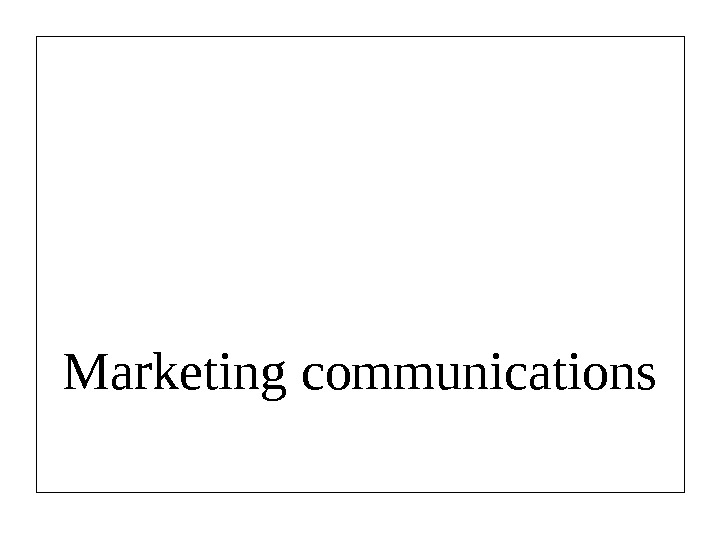










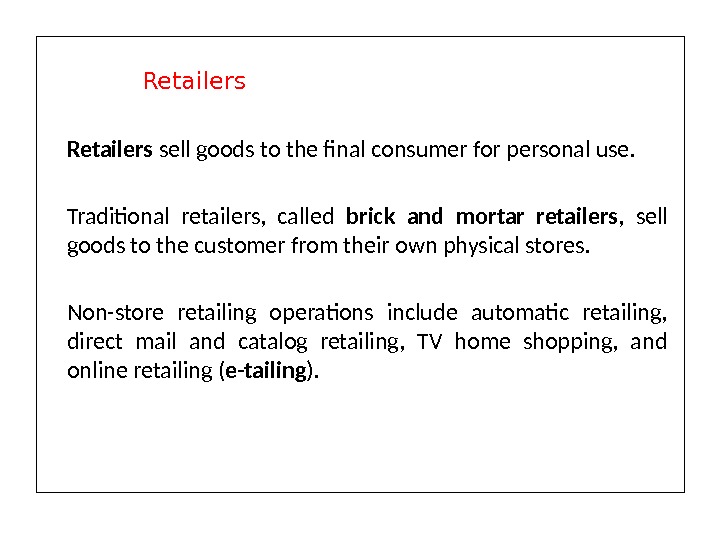











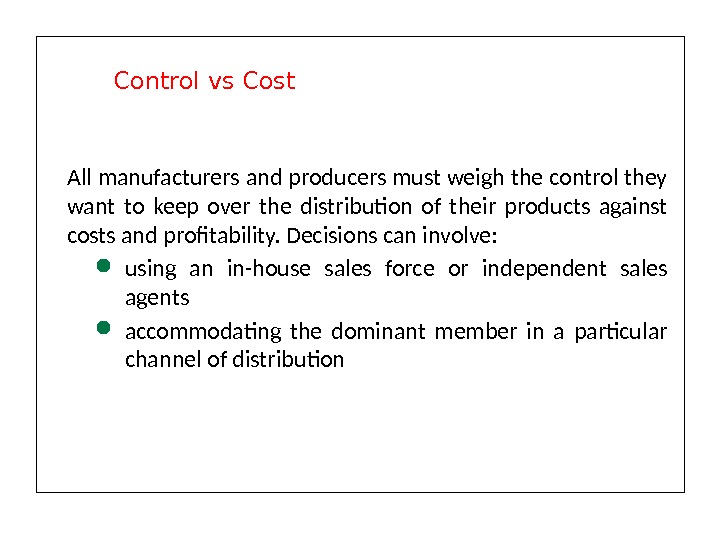

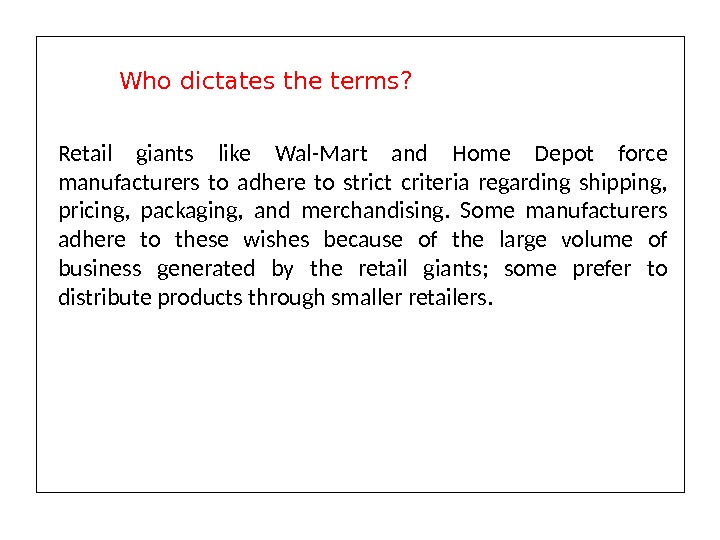


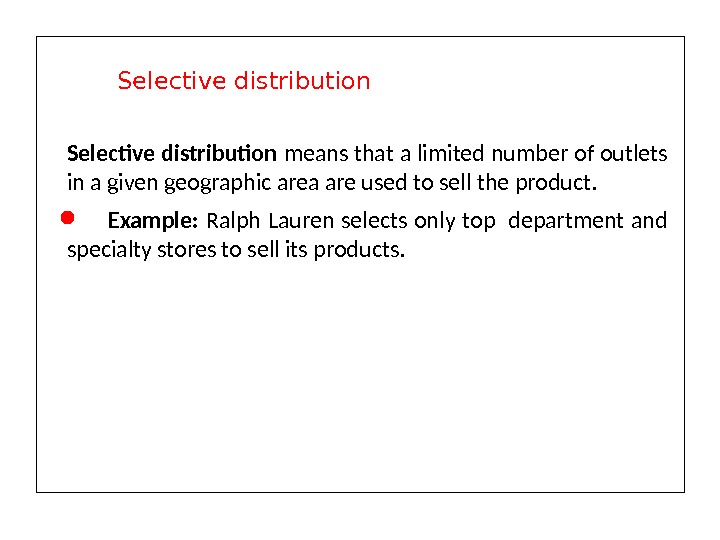



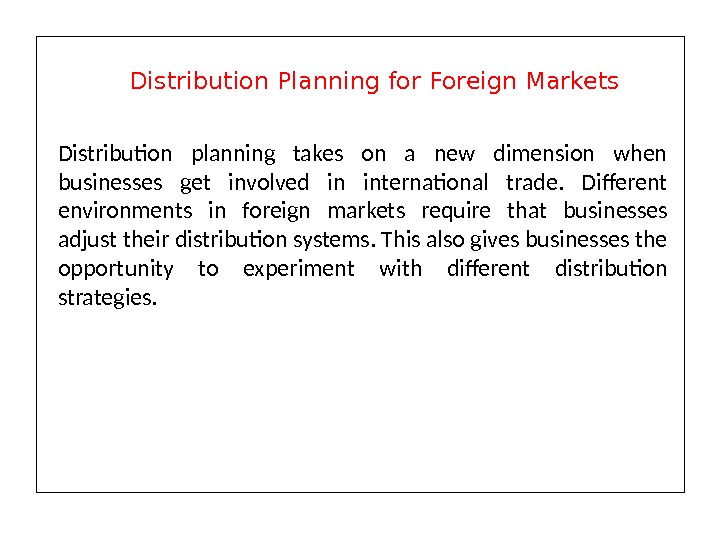


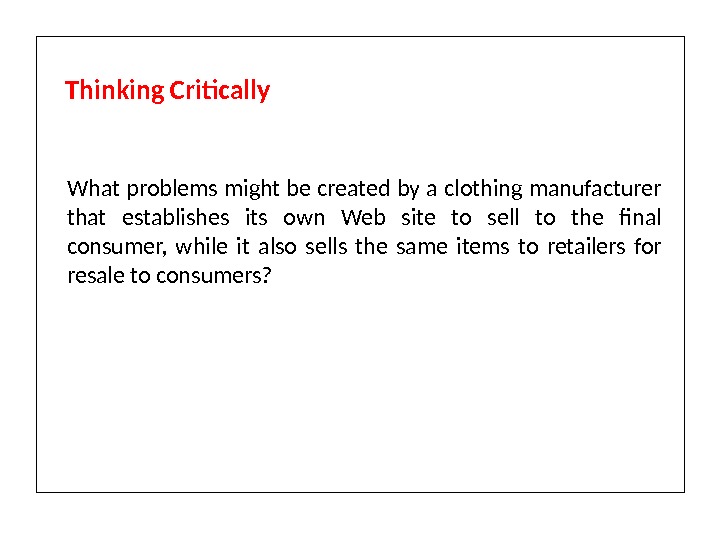

marketing_communications_session_5.ppt
- Размер: 212.9 Кб
- Количество слайдов: 37
Описание презентации Marketing communications SECTION 21. 1 What You’ll по слайдам
 Marketing communications
Marketing communications
 SECTION 21. 1 What You’ll Learn The concept of a channel of distribution Who channel members are Non-store retailing methods How channels of distribution differ for consumer and business-to-business products Distribution
SECTION 21. 1 What You’ll Learn The concept of a channel of distribution Who channel members are Non-store retailing methods How channels of distribution differ for consumer and business-to-business products Distribution
 SECTION 21. 1 Why It’s Important As you know, the marketing mix includes decisions about product, price, place, and promotion. In this chapter you will explore the place decision—that is, how the product will be distributed and sold in the marketplace. Making the correct place decision has an impact on the entire operation of a business. Distribution
SECTION 21. 1 Why It’s Important As you know, the marketing mix includes decisions about product, price, place, and promotion. In this chapter you will explore the place decision—that is, how the product will be distributed and sold in the marketplace. Making the correct place decision has an impact on the entire operation of a business. Distribution
 SECTION 21. 1 Key Terms channel of distribution intermediaries wholesalers rack jobbers drop shippers retailers brick and mortar retailers e-tailing agents direct distribution indirect distribution Distribution
SECTION 21. 1 Key Terms channel of distribution intermediaries wholesalers rack jobbers drop shippers retailers brick and mortar retailers e-tailing agents direct distribution indirect distribution Distribution
 The channel of distribution is the path a product takes from producer or manufacturer to final user. This is a Place decision, one of the four Ps of the marketing mix. Distribution – how it works
The channel of distribution is the path a product takes from producer or manufacturer to final user. This is a Place decision, one of the four Ps of the marketing mix. Distribution – how it works
 All the businesses involved in sales transactions that move products from the manufacturer to the final user are called intermediaries or middlemen. Intermediaries provide value to producers because they often have expertise in certain areas that producers do not have. Channel members
All the businesses involved in sales transactions that move products from the manufacturer to the final user are called intermediaries or middlemen. Intermediaries provide value to producers because they often have expertise in certain areas that producers do not have. Channel members
 Intermediaries reduce the number of transactions required by manufacturers to reach their final customers. What expenses of doing business are lowered by this reduction in transactions? Intermediaries
Intermediaries reduce the number of transactions required by manufacturers to reach their final customers. What expenses of doing business are lowered by this reduction in transactions? Intermediaries
 Channels of distribution Consumers Wholesalers Agents Retailers. Manufacturers / Producers
Channels of distribution Consumers Wholesalers Agents Retailers. Manufacturers / Producers
 Wholesalers buy large quantities of goods (taking title) from manufacturers, store the goods, and then resell them to other businesses. Their customers are called retailers. They may be called distributors when their customers are professional or commercial users, manufacturers, governments, institutions, or other wholesalers. Wholesalers
Wholesalers buy large quantities of goods (taking title) from manufacturers, store the goods, and then resell them to other businesses. Their customers are called retailers. They may be called distributors when their customers are professional or commercial users, manufacturers, governments, institutions, or other wholesalers. Wholesalers
 Two specialized wholesalers are: rack jobbers drop shippers Rack jobbers manage inventory and merchandising for retailers by counting stock, filling it in when needed, and maintaining store displays. They provide the display racks and bill the retailer only for the goods sold. Wholesalers
Two specialized wholesalers are: rack jobbers drop shippers Rack jobbers manage inventory and merchandising for retailers by counting stock, filling it in when needed, and maintaining store displays. They provide the display racks and bill the retailer only for the goods sold. Wholesalers
 Drop shippers deal in bulk items such as coal, lumber, and chemicals that require special handling. Drop shippers sell the goods to other businesses and have the producer ship the merchandise directly to the buyers. The products are owned, but never handled, by the drop shipper. Wholesalers
Drop shippers deal in bulk items such as coal, lumber, and chemicals that require special handling. Drop shippers sell the goods to other businesses and have the producer ship the merchandise directly to the buyers. The products are owned, but never handled, by the drop shipper. Wholesalers
 Retailers sell goods to the final consumer for personal use. Traditional retailers, called brick and mortar retailers , sell goods to the customer from their own physical stores. Non-store retailing operations include automatic retailing, direct mail and catalog retailing, TV home shopping, and online retailing ( e-tailing ). Retailers
Retailers sell goods to the final consumer for personal use. Traditional retailers, called brick and mortar retailers , sell goods to the customer from their own physical stores. Non-store retailing operations include automatic retailing, direct mail and catalog retailing, TV home shopping, and online retailing ( e-tailing ). Retailers
 Shopping on the web Note the millions of dollars attributed to online sales by e-tailers in one month. Which three sectors lead the list? How might this list be changed if the month was December? Top e-tailing sectors Air Travel Books Hardware Software Apparel Hotels Toys/games Music Health, beauty Electronics. Source: Dow Jones MILLIONS OF DOLLARS $318 $224 $187 $182 $164 $146 $143 $
Shopping on the web Note the millions of dollars attributed to online sales by e-tailers in one month. Which three sectors lead the list? How might this list be changed if the month was December? Top e-tailing sectors Air Travel Books Hardware Software Apparel Hotels Toys/games Music Health, beauty Electronics. Source: Dow Jones MILLIONS OF DOLLARS $318 $224 $187 $182 $164 $146 $143 $
 Unlike wholesalers and retailers, agents do not own the goods they sell. Agents act as intermediaries by bringing buyers and sellers together. Example: Real estate agents, food brokers, independent manufacturer’s representatives. Agents
Unlike wholesalers and retailers, agents do not own the goods they sell. Agents act as intermediaries by bringing buyers and sellers together. Example: Real estate agents, food brokers, independent manufacturer’s representatives. Agents
 Channels of distribution are classified as direct or indirect. Direct distribution occurs when the goods or services are sold from the producer directly to the customer; no intermediaries are involved. Indirect distribution involves one or more intermediaries. Direct and Indirect Channels
Channels of distribution are classified as direct or indirect. Direct distribution occurs when the goods or services are sold from the producer directly to the customer; no intermediaries are involved. Indirect distribution involves one or more intermediaries. Direct and Indirect Channels
 Different channels of distribution are generally used to reach the customer in the consumer and industrial markets. Both markets make use of direct and indirect distribution. Channels in the Consumer and Industrial Markets
Different channels of distribution are generally used to reach the customer in the consumer and industrial markets. Both markets make use of direct and indirect distribution. Channels in the Consumer and Industrial Markets
 Reviewing Key Terms and Concepts 1. What is a channel of distribution? 2. Name two major types of merchant intermediaries. 3. What type of intermediary is a rack jobber? A drop shipper? 4. Distinguish between brick and mortar and online retailers. 5. Which type of distribution channel—direct or indirect—is used more frequently for consumer products? For industrial products?
Reviewing Key Terms and Concepts 1. What is a channel of distribution? 2. Name two major types of merchant intermediaries. 3. What type of intermediary is a rack jobber? A drop shipper? 4. Distinguish between brick and mortar and online retailers. 5. Which type of distribution channel—direct or indirect—is used more frequently for consumer products? For industrial products?
 Do you think e-tailing will eventually replace brick and mortar retailers? Explain. Thinking Critically
Do you think e-tailing will eventually replace brick and mortar retailers? Explain. Thinking Critically
 SECTION 21. 2 What You’ll Learn The key considerations in distribution planning When to use multiple channels of distribution How to compare the costs and control involved in having a direct sales force vs. using independent sales agents The three levels of distribution intensity The effect of the Internet on distribution planning The challenges involved in distribution planning for international markets Distribution planning
SECTION 21. 2 What You’ll Learn The key considerations in distribution planning When to use multiple channels of distribution How to compare the costs and control involved in having a direct sales force vs. using independent sales agents The three levels of distribution intensity The effect of the Internet on distribution planning The challenges involved in distribution planning for international markets Distribution planning
 Why It’s Important Distribution decisions affect the entire company so it is important for you to know how they are made. It is also helpful to know how they are carried out in different markets, including international and e-marketplaces. SECTION 21. 2 Distribution planning
Why It’s Important Distribution decisions affect the entire company so it is important for you to know how they are made. It is also helpful to know how they are carried out in different markets, including international and e-marketplaces. SECTION 21. 2 Distribution planning
 Key Terms exclusive distribution integrated distribution selective distribution intensive distribution e-marketplace. SECTION 21. 2 Distribution planning
Key Terms exclusive distribution integrated distribution selective distribution intensive distribution e-marketplace. SECTION 21. 2 Distribution planning
 Distribution planning involves decisions about a product’s physical movement and transfer of ownership from producer to consumer. Distribution decisions affect a firm’s marketing program. Some of the major considerations are: the use of multiple channels control vs. costs intensity of distribution desired involvement in e-commerce. Distribution planning
Distribution planning involves decisions about a product’s physical movement and transfer of ownership from producer to consumer. Distribution decisions affect a firm’s marketing program. Some of the major considerations are: the use of multiple channels control vs. costs intensity of distribution desired involvement in e-commerce. Distribution planning
 Multiple channels are used when a product fits both industrial and customer needs. Example: Cookies sold to supermarkets and airlines. Retailers also use multiple channels. Example: A stationary store sells to the public and sells office supplies to businesses. Multiple channels
Multiple channels are used when a product fits both industrial and customer needs. Example: Cookies sold to supermarkets and airlines. Retailers also use multiple channels. Example: A stationary store sells to the public and sells office supplies to businesses. Multiple channels
 All manufacturers and producers must weigh the control they want to keep over the distribution of their products against costs and profitability. Decisions can involve: using an in-house sales force or independent sales agents accommodating the dominant member in a particular channel of distribution. Control vs Cost
All manufacturers and producers must weigh the control they want to keep over the distribution of their products against costs and profitability. Decisions can involve: using an in-house sales force or independent sales agents accommodating the dominant member in a particular channel of distribution. Control vs Cost
 A manufacturer can decide to use its own sales force or hire agents to do the selling, depending on how much control it wants over sales. Direct Sales Force Costly; manufacturer maintains complete control. Agent Less costly; manufacturer loses some control over how sales are made. Who does the selling?
A manufacturer can decide to use its own sales force or hire agents to do the selling, depending on how much control it wants over sales. Direct Sales Force Costly; manufacturer maintains complete control. Agent Less costly; manufacturer loses some control over how sales are made. Who does the selling?
 Retail giants like Wal-Mart and Home Depot force manufacturers to adhere to strict criteria regarding shipping, pricing, packaging, and merchandising. Some manufacturers adhere to these wishes because of the large volume of business generated by the retail giants; some prefer to distribute products through smaller retailers. Who dictates the terms?
Retail giants like Wal-Mart and Home Depot force manufacturers to adhere to strict criteria regarding shipping, pricing, packaging, and merchandising. Some manufacturers adhere to these wishes because of the large volume of business generated by the retail giants; some prefer to distribute products through smaller retailers. Who dictates the terms?
 Distribution intensity has to do with how widely a product will be distributed. There are three levels of distribution intensity: exclusive selective intensive. Distribution intensity
Distribution intensity has to do with how widely a product will be distributed. There are three levels of distribution intensity: exclusive selective intensive. Distribution intensity
 Exclusive distribution involves protected territories for distribution of a product in a geographic area. Example: Retailers associated with National Auto Parts Association (NAPA) buy stock from NAPA and participate in its promotions. A variation is integrated distribution , in which a manufacturer acts as wholesaler and retailer for its own products. Exclusive distribution
Exclusive distribution involves protected territories for distribution of a product in a geographic area. Example: Retailers associated with National Auto Parts Association (NAPA) buy stock from NAPA and participate in its promotions. A variation is integrated distribution , in which a manufacturer acts as wholesaler and retailer for its own products. Exclusive distribution
 Selective distribution means that a limited number of outlets in a given geographic area are used to sell the product. Example: Ralph Lauren selects only top department and specialty stores to sell its products. Selective distribution
Selective distribution means that a limited number of outlets in a given geographic area are used to sell the product. Example: Ralph Lauren selects only top department and specialty stores to sell its products. Selective distribution
 Intensive distribution involves use of all suitable outlets for a product. The objective is complete market coverage, and the ultimate goal is to sell to as many customers as possible. Example: Motor oil is sold in supermarkets, parts retailers, hardware stores, warehouse clubs, even mini marts. Intensive distribution
Intensive distribution involves use of all suitable outlets for a product. The objective is complete market coverage, and the ultimate goal is to sell to as many customers as possible. Example: Motor oil is sold in supermarkets, parts retailers, hardware stores, warehouse clubs, even mini marts. Intensive distribution
 E-commerce is the means by which products are sold to customers and industrial buyers through use of the Internet. In 2000 almost half of America’s top retailers sold online. E-commerce
E-commerce is the means by which products are sold to customers and industrial buyers through use of the Internet. In 2000 almost half of America’s top retailers sold online. E-commerce
 Businesses use the Web to sell to consumers and to facilitate industrial sales. Example: Panasonic uses its public Web site for information only, but it has a B 2 B Web site where retailers can check orders, pricing, and promotions. E-commerce
Businesses use the Web to sell to consumers and to facilitate industrial sales. Example: Panasonic uses its public Web site for information only, but it has a B 2 B Web site where retailers can check orders, pricing, and promotions. E-commerce
 Distribution planning takes on a new dimension when businesses get involved in international trade. Different environments in foreign markets require that businesses adjust their distribution systems. This also gives businesses the opportunity to experiment with different distribution strategies. Distribution Planning for Foreign Markets
Distribution planning takes on a new dimension when businesses get involved in international trade. Different environments in foreign markets require that businesses adjust their distribution systems. This also gives businesses the opportunity to experiment with different distribution strategies. Distribution Planning for Foreign Markets
 E-marketplaces for B 2 B operations provide one-stop shopping and savings for industrial buyers. Why would a business opt to be part of an e-marketplace rather than have its own Web site? Going to the e-marketplace Sales of goods and services via electronic marketplaces are projected to skyrocket
E-marketplaces for B 2 B operations provide one-stop shopping and savings for industrial buyers. Why would a business opt to be part of an e-marketplace rather than have its own Web site? Going to the e-marketplace Sales of goods and services via electronic marketplaces are projected to skyrocket
 Reviewing Key Terms and Concepts 1. What key factors are considered when developing an effective distribution plan? 2. When are multiple distribution channels used? 3. Give two reasons for using a direct sales force instead of independent sales agents. 4. What are the levels of distribution intensity? 5. Explain the challenges businesses face when getting involved with distribution planning in Japan.
Reviewing Key Terms and Concepts 1. What key factors are considered when developing an effective distribution plan? 2. When are multiple distribution channels used? 3. Give two reasons for using a direct sales force instead of independent sales agents. 4. What are the levels of distribution intensity? 5. Explain the challenges businesses face when getting involved with distribution planning in Japan.
 What problems might be created by a clothing manufacturer that establishes its own Web site to sell to the final consumer, while it also sells the same items to retailers for resale to consumers? Thinking Critically
What problems might be created by a clothing manufacturer that establishes its own Web site to sell to the final consumer, while it also sells the same items to retailers for resale to consumers? Thinking Critically
 Questions?
Questions?

